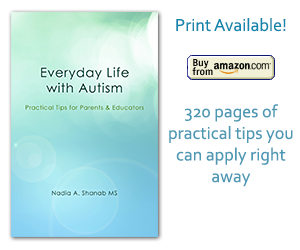Nadia Shanab | Uncategorized
A research from the Keck School of Medicine of the University of Southern California was recently published suggesting: “Children with both the risk of autism genotype and exposure to high air polluant levels were at increased risk of autism spectrum disorder compared to those without the risk genotype and lower air pollution exposure.” This study
[read more]
Comments Off on Air Pollution Increases The Risk of Autism
Nadia Shanab | Uncategorized
Why do children with autism repeat and echo the questions they are asked? We agreed that the wiring of the brain in individuals with autism is different, compared to NTs (Neurotypically developed peers). Consequently, The processing or thinking speed of a child with autism is sometimes different. And while the child is trying to process/think
[read more]
Comments Off on Why Does My Child Repeat and Echo?
Nadia Shanab | Uncategorized
Yesterday I ran into a former student accompanied by his family, mother, father, and sister in a shopping mall. His mom was the one who gave me a pat on the shoulder coming from behind me. She looked at me with a big smile and sparkling eyes, full of joy and excitement, wondering if I
[read more]
30 Nov 2013 | Tags:
autism,
communication,
discipline,
early intervention,
eye contact,
flexibility,
health,
independence,
parenting,
schedule,
social interaction,
tips Comments Off on Success Story
Nadia Shanab | Uncategorized
Tip Give your child the opportunity to play a musical instrument at an early age. Help your child explore and experience the practice of playing music and look for her favorite instrument. It may take time to land on the perfect instrument that matches your child’s interest and needs. Be patient don’t give up. Why
[read more]
26 Nov 2013 | Tags:
asperger's syndrome,
autism,
communication,
discipline,
flexibility,
health,
independence,
occupational therapy,
parenting,
research,
senses,
sensory,
social interaction,
speech,
tips Comments Off on The Benefits of Playing Music on The Brain
Nadia Shanab | Uncategorized
I used to work with a student who was obsessively writing letters, numbers, and symbols in the air using her index. I was so puzzled about this behavior, because it didn’t look appropriate in other poeple’s eyes. My idea was to help her use another medium to write on that looked more appropriate and channel
[read more]
Comments Off on Anecdote: Memory Problem or Sensory Issue
Nadia Shanab | Uncategorized
There are three other conditions/diseases that may overlap with autism. Your child has been diagnosed with autism, but beware of other symptoms that may hide under the ASD ambrella. Epilepsy, Tourette Syndrome, and Mitocondrial Disease. The good new is that treatments administered to cure these conditions can also benefit your child with autism. 1-Is your
[read more]
25 Nov 2013 | Tags:
asperger's syndrome,
autism,
diagnosis,
early intervention,
epilepsy,
health,
Mitchondrial disease,
parenting,
research,
symptoms of autism,
tips,
Tourette Syndrome Comments Off on Beware of 3 Conditions Overlapping with Autism
Nadia Shanab | Uncategorized
If you are expecting your child or students to consistently comply, obey, agree, and follow your directions every time you ask her, you must be dreaming. This is just so unrealistic. Whether your child/student is on the autism spectrum or not, it is unlikly that you’ll to be listened to all the time. Parents and
[read more]
Comments Off on How to Deal with Oppositional Defiant Behavior
Nadia Shanab | Uncategorized
“There’s no reason to miss out on holiday gatherings” Here are some tips to help parents of special needs kids to enjoy the holiday season and be part of their community and stay connected to their family and friends. Don’t turn down any invitations. You’ll be pleasantly surprised how interesting your experience was. Read the
[read more]
21 Nov 2013 | Tags:
ADHD,
asperger's syndrome,
autism,
communication,
flexibility,
health,
holidays,
independence,
organization,
parenting,
senses,
sensory,
social interaction,
tips Comments Off on My New Article in The San Jose Mercury News This Week
Nadia Shanab | Uncategorized
A study published in the journal Nature, Nov 6, reveals the earliest sign of developing auism ever observed: a steady decline in attention to others’ eyes within the first two to six months of life. Autism is usually diagnosed around the age of 2, when a significant delay in speech and poor social skills are
[read more]
Comments Off on Eye-Looking as An Early Marker for Autism
Nadia Shanab | Uncategorized
In a new finding from Stanford University, research was done on individuals with high-functioning autism with IQ higher than 70, shows that the connecivity in the brain is high compared to their peers with typically developed brain. This finding is challenging previous belief that: individuals with autism have lower connectivity in brain regions. “Using one
[read more]
Comments Off on Hyper Connectivity in The Brain Related to Autism

